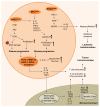Immunotherapy in Myeloproliferative Diseases
- PMID: 32604862
- PMCID: PMC7349594
- DOI: 10.3390/cells9061559
Immunotherapy in Myeloproliferative Diseases
Abstract
Myeloproliferative diseases, including myeloproliferative neoplasms (MPN) and myelodysplastic syndromes (MDS), are driven by genetic abnormalities and increased inflammatory signaling and are at high risk to transform into acute myeloid leukemia (AML). Myeloid-derived suppressor cells were reported to enhance leukemia immune escape by suppressing an effective anti-tumor immune response. MPNs are a potentially immunogenic disease as shown by their response to interferon-α treatment and allogeneic hematopoietic stem-cell transplantation (allo-HSCT). Novel immunotherapeutic approaches such as immune checkpoint inhibition, tumor vaccination, or cellular therapies using target-specific lymphocytes have so far not shown strong therapeutic efficacy. Potential reasons could be the pro-inflammatory and immunosuppressive microenvironment in the bone marrow of patients with MPN, driving tumor immune escape. In this review, we discuss the biology of MPNs with respect to the pro-inflammatory milieu in the bone marrow (BM) and potential immunotherapeutic approaches.
Keywords: AML; CD123; IFNα; JAK2; MDS; MDSCs; MPN; allo-HSCT; immune checkpoint; immune escape; immunotherapy; inflammation; myeloproliferation; tumor vaccination.
Conflict of interest statement
The authors declare no conflicts of interest.
Figures

Similar articles
-
Immunotherapy for myeloproliferative neoplasms (MPN).Curr Cancer Drug Targets. 2011 Jan;11(1):72-84. doi: 10.2174/156800911793743682. Curr Cancer Drug Targets. 2011. PMID: 21062247 Review.
-
Inflammatory Microenvironment and Specific T Cells in Myeloproliferative Neoplasms: Immunopathogenesis and Novel Immunotherapies.Int J Mol Sci. 2021 Feb 14;22(4):1906. doi: 10.3390/ijms22041906. Int J Mol Sci. 2021. PMID: 33672997 Free PMC article. Review.
-
The Rationale for Immunotherapy in Myeloproliferative Neoplasms.Curr Hematol Malig Rep. 2019 Aug;14(4):310-327. doi: 10.1007/s11899-019-00527-7. Curr Hematol Malig Rep. 2019. PMID: 31228096 Review.
-
Myeloid-derived suppressor cells: Implication in myeloid malignancies and immunotherapy.Acta Histochem. 2024 Oct;126(5-7):152183. doi: 10.1016/j.acthis.2024.152183. Epub 2024 Jul 18. Acta Histochem. 2024. PMID: 39029317 Review.
-
Programmed cell death-1 pathway inhibition in myeloid malignancies: implications for myeloproliferative neoplasms.Ann Hematol. 2017 Jun;96(6):919-927. doi: 10.1007/s00277-016-2915-4. Epub 2017 Jan 6. Ann Hematol. 2017. PMID: 28062906 Review.
Cited by
-
Associations of the circulating levels of cytokines with the risk of myeloproliferative neoplasms: a bidirectional mendelian-randomization study.BMC Cancer. 2024 Apr 26;24(1):531. doi: 10.1186/s12885-024-12301-x. BMC Cancer. 2024. PMID: 38671390 Free PMC article.
-
Merkel cell carcinoma in collision with squamous cell carcinoma and basal cell carcinoma in a patient on ruxolitinib treatment for myeloproliferative neoplasm.JAAD Case Rep. 2024 Feb 2;45:98-101. doi: 10.1016/j.jdcr.2024.01.024. eCollection 2024 Mar. JAAD Case Rep. 2024. PMID: 38434601 Free PMC article. No abstract available.
-
Single-cell Multiomics Analysis of Myelodysplastic Syndromes and Clinical Response to Hypomethylating Therapy.Cancer Res Commun. 2024 Feb 12;4(2):365-377. doi: 10.1158/2767-9764.CRC-23-0389. Cancer Res Commun. 2024. PMID: 38300528 Free PMC article.
-
PD-L1 overexpression correlates with JAK2-V617F mutational burden and is associated with 9p uniparental disomy in myeloproliferative neoplasms.Am J Hematol. 2022 Apr;97(4):390-400. doi: 10.1002/ajh.26461. Epub 2022 Jan 21. Am J Hematol. 2022. PMID: 35015307 Free PMC article.
-
Progression of Myeloproliferative Neoplasms (MPN): Diagnostic and Therapeutic Perspectives.Cells. 2021 Dec 16;10(12):3551. doi: 10.3390/cells10123551. Cells. 2021. PMID: 34944059 Free PMC article. Review.
References
-
- Barbui T., Thiele J., Gisslinger H., Kvasnicka H.M., Vannucchi A.M., Guglielmelli P., Orazi A., Tefferi A. The 2016 who classification and diagnostic criteria for myeloproliferative neoplasms: Document summary and in-depth discussion. Blood Cancer J. 2018;8:15. doi: 10.1038/s41408-018-0054-y. - DOI - PMC - PubMed
-
- Rampal R., Ahn J., Abdel-Wahab O., Nahas M., Wang K., Lipson D., Otto G.A., Yelensky R., Hricik T., McKenney A.S., et al. Genomic and functional analysis of leukemic transformation of myeloproliferative neoplasms. Proc. Natl. Acad. Sci. USA. 2014;111:E5401–E5410. doi: 10.1073/pnas.1407792111. - DOI - PMC - PubMed
Publication types
MeSH terms
LinkOut - more resources
Full Text Sources
Research Materials
Miscellaneous

